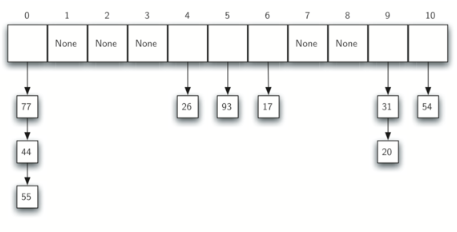排序和搜索
15 in [3,3,2,1,4]False
3 in [3,4,5,6]True
顺序查找
# 查找列表中的项,假设列表项无序
def sequence_search(alist,item):
pos = 0
found = False
while pos<len(alist) and not found:
if alist[pos]==item:
found = True
else:
pos += 1
return found
testlist = [1, 2, 32, 8, 17, 19, 42, 13, 0]
print(sequence_search(testlist, 3))
print(sequence_search(testlist, 13)) False
True
# 查找列表中的项,假设列表项有序
def order_sequence_search(alist,item):
pos = 0
found = False
stop = False
while pos < len(alist) and not found and not stop:
if alist[pos] == item:
found = True
else:
if alist[pos]>item:
stop = True
else:
pos += 1
return found
testlist = [0, 1, 2, 8, 13, 17, 19, 32, 42,]
print(order_sequence_search(testlist, 3))
print(order_sequence_search(testlist, 13))False
True
二分法查找
def binary_search(alist,item):
first = 0
last = len(alist)-1
found = False
while first<=last and not found:
mid = (first+last)/2
if alist[mid]==item:
found = True
elif alist[mid]>item:
last = mid - 1
else:
first = mid + 1
return found
testlist = [0, 1, 2, 8, 13, 17, 19, 32, 42,]
print(binary_search(testlist, 3))
print(binary_search(testlist, 13)) False
True
# 递归实现
def bianary_search(alist,item):
if len(alist)==0:
return False
else:
mid = len(alist)//2
if alist[mid]==item:
return True
else:
if item<alist[mid]:
return bianary_search(alist[:mid],item)
else:
return bianary_search(alist[mid+1:],item)
testlist = [0, 1, 2, 8, 13, 17, 19, 32, 42,]
print(binary_search(testlist, 3))
print(binary_search(testlist, 13)) False
True
Hash查找
哈希表 是以一种容易找到它们的方式存储的项的集合。哈希表的每个位置,通常称为一个槽,可以容纳一个项,并且由从 0 开始的整数值命名。例如,我们有一个名为 0 的槽,名为 1 的槽,名为 2 的槽,以上。最初,哈希表不包含项,因此每个槽都为空。我们可以通过使用列表来实现一个哈希表,每个元素初始化为None 。Figure 4 展示了大小 m = 11 的哈希表。换句话说,在表中有 m 个槽,命名为 0 到 10。

具体介绍见:Hash查找
def hash(astring, tablesize):
sum = 0
for pos in range(len(astring)):
sum = sum+ord(astring[pos])
return sum%tablesize冲突解决:

排序
# 冒泡排序
def bubble_sort_1(alist):
for j in range(len(alist)-1,0,-1):
for i in range(j):
if alist[i]>alist[i+1]:
alist[i],alist[i+1]=alist[i+1],alist[i]
return alist
alist = [54,26,93,17,77,31,44,55,20]
print bubble_sort_1(alist)[17, 20, 26, 31, 44, 54, 55, 77, 93]
# 优化冒泡排序,识别有序序列,修改冒泡排序提前停止
def bubble_sort_2(alist):
exchange = True
j = len(alist)-1
while j>0 and exchange:
exchange = False
for i in range(j):
if alist[i] > alist[i+1]:
alist[i],alist[i+1]=alist[i+1],alist[i]
exchange = True
j -= 1
return alist
alist=[30,20,40,90,50,60,70,80,100,110]
print bubble_sort_2(alist)[20, 30, 40, 50, 60, 70, 80, 90, 100, 110]
# 简单选择排序
def select_sort(alist):
for i in range(len(alist)):
k = i
for j in range(k,len(alist)):
if alist[k]>alist[j]:
k = j
alist[i],alist[k]=alist[k],alist[i]
return alist
alist = [54,26,93,17,77,31,44,55,20]
print select_sort(alist)[17, 20, 26, 31, 44, 54, 55, 77, 93]
# 插入排序
def insert_sort(alist):
for i in range(0,len(alist)):
for j in range(i+1,len(alist)):
if alist[i]>alist[j]:
tmp = alist[j]
alist.pop(j)
alist.insert(i,tmp)
return alist
alist = [54,26,93,17,77,31,44,55,20]
print insert_sort(alist)[17, 20, 26, 31, 44, 54, 55, 77, 93]
# 插入排序2
def insert_sort_2(A):
length = len(A)
if length < 2:
return A
for i in range(1,length-1):
key = A[i]
j = i-1
while j>=0 and A[j]>key:
A[j+1]=A[j]
j -= 1
A[j+1] = key
return A
alist = [54,26,93,17,77,31,44,55,20]
print insert_sort_2(alist)[17, 26, 31, 44, 54, 55, 77, 93, 20]
更多排序算法见博客:Python排序算法









 本文介绍了几种常见的排序和搜索算法,包括顺序查找、有序顺序查找、二分法查找、冒泡排序、选择排序和插入排序等,并提供了Python实现代码。
本文介绍了几种常见的排序和搜索算法,包括顺序查找、有序顺序查找、二分法查找、冒泡排序、选择排序和插入排序等,并提供了Python实现代码。
















 638
638

 被折叠的 条评论
为什么被折叠?
被折叠的 条评论
为什么被折叠?








